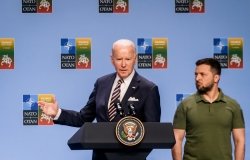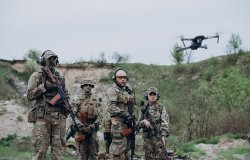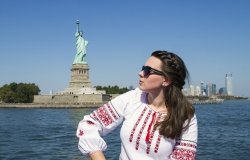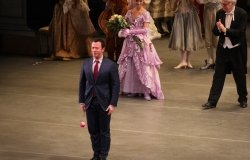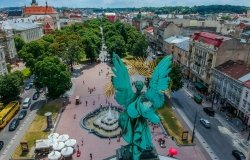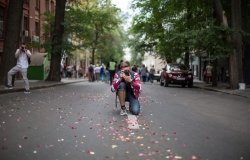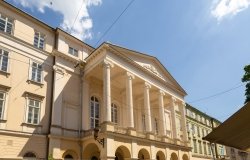
A blog of the Kennan Institute
“Feeding the Enemy” Truths about Ukraine Through Art
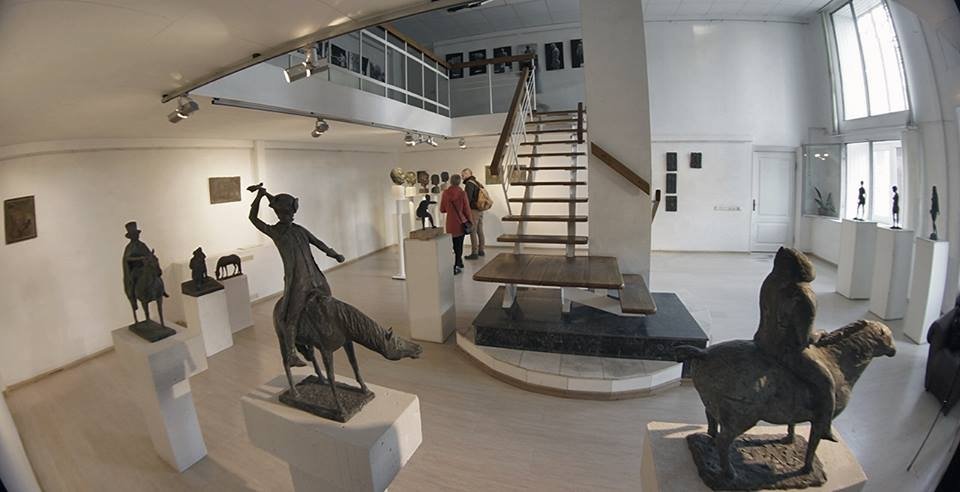
Скульптура. Харківська муніципальна галерея by В. Кочмар. (CC BY-SA 4.0 Deed)
Few Ukrainian cities have been as ravaged by war as Kharkiv. Only 20 miles from the Russian border, Ukraine’s second largest city was among Russia’s initial targets. Despite successfully resisting the initial onslaught, the city has been targeted by Russian rockets, drones, and bombs ever since. Many significant institutions have been severely damaged, including its noteworthy university, its opera house, and its regional government building. The city nonetheless carries on with a defiance that opens the door to a brighter future. The Kharkiv Municipal Gallery (KMG) is one among many local institutions that have continued to function despite unspeakable loss and undeniable hardship.
For nearly three decades, KMG has hosted creative initiatives bringing together the city’s vibrant artistic community. The first municipal art gallery in Ukraine, KMG and its founder Tetyana Tumasyan have promoted contemporary art through a variety of programs, bringing together artists, curators, students, and the public. Its activities—from exhibitions and lectures to classes and seminars—have covered a wide range of art forms, including traditional painting, graphics, sculpture, photography, and new media. KMG has showcased artists from abroad as well as leading Ukrainian artists such as Boris Mykhaylov, Viktor Sydorenko, Anton Tkachenko, and Olkesandr Ridny, among many. One noteworthy program, the 2017 project Ha City, depicted the city’s art over a century, reflecting avant-garde and experimental artistic trends expressed in a variety of mediums.
The current war has only strengthened KMG’s commitment to contemporary Ukrainian culture. Over the New Year’s holiday season, the gallery invited viewers to its downtown location to see a new exhibition, Dish for the Enemy, by Terra Neidorf and curated by Daria Gerasimova.
Neidorf graduated from the Kharkiv State Academy of Design and Arts and is continuing her studies at the Lviv National Academy of Arts. Still in her 20s, she has established herself as a notable creator in environmental, landscape, video, and performance art and photography. Her works have explored the nature of the human body, planet earth, and environmental concerns. She perhaps is best known for her ecological art, which makes use of natural materials.
Dish for the Enemy features photographs of dishes prepared for Russians that are displayed in a basement gallery safe from Russian bombardment. Every dish has been inspired by Ukrainian cuisine, and has been made from earth, sand, stones, wood, plants, and other natural materials expounded on by accompanying text and recipes. Each features ingredients drawn from Kharkiv’s natural environment.
Neidorf’s commentary on the exhibit concedes that “the name of the project may be confusing, as it sounds corny.” Instead, the title and the exhibit are “about the struggle of free-spirited people who will feed everyone who wants it. We do not honor the enemy with our hospitality; we take revenge with it.” She adds, “We know our enemy well. He is not interested in Ukrainian culture, history, achievements, intelligence and talents of our people; he destroys all this. The only thing the enemy is interested in is Ukrainian land. Why not give him what he wants, but on our terms, on the terms of the hosts?”
In happier times, as KMG celebrated its 10th anniversary, the city’s great and good gathered for a party to celebrate. Municipal leaders patted themselves on the back for having launched the project with an eye towards providing the local art world with greater visibility. Within self-congratulations, several formulated a more profound message. The arts infused every aspect of life in the city, yet remained invisible to those who did not look for them. Some of the comments caught by media that evening suggested that the arts might sustain the city in the future.
That future has arrived, and the arts indeed have been central to sustaining Kharkiv. The small gallery showing Dish for the Enemy has been crowded with viewers despite the horrors of war aboveground. Like Neidorf, they are searching for meaning in a conflict that makes no sense.
The opinions expressed in this article are those solely of the author and do not reflect the views of the Kennan Institute.
See our newest content first.
Subscribe to receive the latest analysis from Focus Ukraine
About the Author

Blair A. Ruble
Former Wilson Center Vice President for Programs (2014-2017); Director of the Comparative Urban Studies Program/Urban Sustainability Laboratory (1992-2017); Director of the Kennan Institute for Advanced Russian Studies (1989-2012) and Director of the Program on Global Sustainability and Resilience (2012-2014)

Kennan Institute
The Kennan Institute is the premier US center for advanced research on Russia and Eurasia and the oldest and largest regional program at the Woodrow Wilson International Center for Scholars. The Kennan Institute is committed to improving American understanding of Russia, Ukraine, Central Asia, the Caucasus, and the surrounding region though research and exchange. Read more
